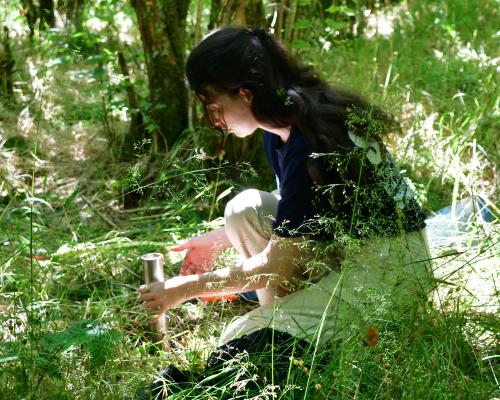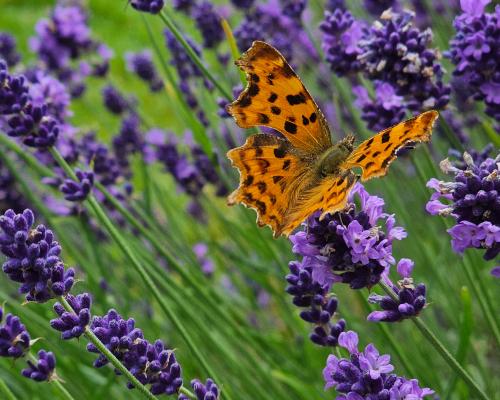
Even in midsummer, the ancient hazelwoods on the Hebridean island of Seil are cool and quiet. Countless slanted stems of hazel support a thick canopy, which blots out the sun and blankets everything below in a sort of “fairytale darkness”, says Bethan Manley, a biologist at the Wellcome Sanger Institute.
Moss and lichen coat branches threaded with honeysuckle, forming a great dome above you, adds David Satori, a researcher at Royal Botanic Gardens, Kew.
This rich forest, on Scotland’s Hebridean islands, is a remnant of one of Britain’s oldest woodland environments. When the last ice age ended, the mile-thick glacier that had buried northern Europe melted away and hazelnuts sprouted across the rock left behind.
Scientists can date when those forests sprang up across the west coast of Britain and Ireland, says Satori, because “about 10,000 years ago, you have a massive spike in hazel pollen”. Scottish lichenologists have estimated these particular woodlands might have been around since 7,500BC.
“That’s older than any pine forest [in the UK]. Older than any ancient oakwood that we have down south,” Satori says. “One of the oldest woodlands in the British Isles.”
Today, only a few tiny patches of old growth remain. Satori and Manley have come to this 49-hectare (121-acre) woodland reserve, the Ballachuan Hazelwood, to find the country’s best example.
From the outside, the bush-like stand appears so unremarkable that you could walk right past and miss it.
Their target within the woodland is even less conspicuous, hinted at by dead branches that hang eerily from the trees and what Satori describes as “stubby orange finger-like structures that grip hazel branches”.
These ancient woods are home to peculiar fungi, including the glue crust fungus that sticks together hazel branches, and the parasitic “hazel gloves” that grow out of them.
Here, the researchers aim to understand how fungal communities could be key to regrowing Britain’s lost hazelwoods, one part of a global mission to map the forgotten subterranean half of our planet’s forests.
In the last few years, Britain has tentatively begun to embrace its status as a nation of rainforests. Its woodlands, which spend much of the year blanketed in mist or rain, are a distinct form of temperate rainforest, one that survives only in western Scotland. After the success of Guy Shrubsole’s bestselling The Lost Rainforests of Britain, the UK government announced plans to restore the nation’s rainforests, which have dwindled to less than 1% of land in Great Britain.
New research led by Leeds University shows the UK could play a globally significant role in reversing the decline of these rainforests. Temperate rainforests are a rare ecosystem that covers less than 1% of the Earth’s land, restricted to cool, moist conditions that are easily affected by climate change.
Planet-wide, about two-thirds of temperate rainforests could be lost as weather patterns shift, according to that research – with some nations, such as Austria, losing 90%. But the UK and Ireland have large expanses of unforested and rainy land, meaning these two countries have an opportunity to become “global leaders in restoration and reforestation of temperate rainforest,” the authors write.
Forests’ ability to regrow, however, is strongly dependent on the communities of mycorrhizal fungi that grow symbiotically with roots, allowing the fungi and tree to exchange nutrients. Although mycorrhizal fungi have seen huge declines across Europe, being planted in native soil microbiome with healthy fungi can stimulate the growth of trees and other plants by 64%, research has shown.
The first problem for hazelwood rainforests, as well as many rare forests across the planet, is that no one knows what this subterranean ecology involves, says Satori. “Hardly anything has been done to understand these communities,” he says. About three-quarters of fungi are “dark taxa” – species known only by their DNA sequence, as physical specimens have not been found.
Over the next two years, Satori will be documenting soil fungi at Ballachuan and more than 20 other sites to establish the first ever map of mycorrhizal communities across Britain’s temperate rainforest zones.
Today, he is driving a metal coring device down into the soil around the hazel’s roots. It pulls out root tips, to see what is associating with the hazel, while also sampling soil environmental DNA. This “eDNA” can give a broad picture of the range of fungi that are down there, which play different roles in the ecosystem.
Satori’s work is supported by the Society for the Protection of Underground Networks (Spun), a research organisation founded in 2021 to analyse mycorrhizal fungal communities and advocate for their protection.
The sampling work in Seil links Scotland’s chill forests to similarly endangered, yet very different, rainforests in Colombia and Palmyra island, the Earth’s most remote atoll. At each of the research sites, the below-ground microbiome – which the organisation calls the “circulatory system of the planet” – is being probed to produce a global map, which was recently published in the journal Nature.
In the richly biodiverse Magdalena River valley in Colombia, they are testing areas of rainforest cleared for cattle ranching, to see whether these fields still have similar fungal microbiomes as areas of untouched primary rainforest, or have flipped into new states.
In areas now abandoned by farmers, Spun is monitoring to see if places that are rich in forest fungi naturally regrow better –and produce a map of the fungi-rich locations that may be best for replanting.
The challenge in the UK is in some ways more extreme than Colombia, says Manley. While much of the Colombian farmland was cleared in recent decades, “in some areas of Scotland you haven’t had forests for maybe 1,000 years,” she says, potentially leaving trees with little fungal life to support them, making them more vulnerable to drought and other stresses.
Across the British Isles, a number of efforts to restore rainforests are now under way. At Bowden Pillars, a 30-hectare “rainforest creation” site in Totnes, the Devon Wildlife Trust (DWT) commissioned soil analysis to help to understand the impact of historical use of the site has had on the land, says Claire Inglis, nature reserve officer at DWT.
Although volunteers have already planted more than 2,500 trees, the project aims first and foremost to design ways that seeds and fungi can spread naturally, as “natural colonisation is always your most resilient option for future woodland,” says Inglis, adding that they were still only beginning to understand how to restore fungal communities.
More hands-on measures have been considered by the DWT and the National Trust, which is restoring rainforest in north Devon. These include soil restoration by “inoculation”, either by adding scoops of soil from intact ecosystems when trees are planted or by transplanting fungal spores.
Felicity Roos, a soil consultant at the National Trust, says: “In the right circumstances, restoring degraded landscapes and soils, inoculants can play an important role in restoration.” Commercial biofertilisers claiming to contain mycorrhizal spores are now a business worth billions, but scientific studies have shown the majority of products contain dead or ineffective spores, with some also containing pathogens, or disease-causing micro-organisms.
Such restoration projects underscore the importance of preserving remnants such as Ballachuan, and other reserves or fragments of rainforest around the world. These ancient patches act as “refugia”: reservoirs of fungi that can then act as a source to spread across the patchwork of different habitat types – farmland, developed land, semi-natural wild land – that surround it.
Much of the UK’s temperate rainforest is fragmented into these small pieces on land belonging to different farmers and estates. Satori says restoration will require reconnecting these across the whole landscape so as to have bridges that allow not just fungi but animals and insects to travel across the land. “Having these interconnected landscapes is definitely going to be the best way to move forward,” he says. “It’s very much a long-term vision.”





